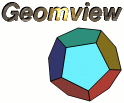 Home Overview FAQ Documentation Download Mailing List Geomview For Windows? Support Users Development Bug Reporting Contributing Contact Us Sponsors
|
[Date Prev][Date Next][Thread Prev][Thread Next][Date Index][Thread Index] Re: [Update REQ 6232]: Geomview
Hello Stuart,
On Tue, 1 Jul 1997 daemon at geom.umn.edu wrote:
> From: Stuart Levy <slevy>
> Date: Tue, 1 Jul 1997 23:37:57 -0500
> Message-Id: <199707020437.XAA00599 at riemann.geom.umn.edu>
> To: software@geom.umn.edu
> Subject: Re: [Update REQ 6232]: Geomview
>
> ... cut ...
>
> Simplest way to get some sort of marking: create some points,
> placed say in the center of the selected faces. (You could do that with e.g.
> appearance { linewidth 3 }
> followed by a VECT object with a bunch of 1-vertex polylines (i.e. dots)
> coinciding with the face centers.) Since geomview automatically makes
> points & lines, which coincide with a face, visible from *both* sides
> of the face, this should work well.
Yeah, a colleague mentioned a FE package he'd used which drew little
asterisks on faces to let you know you'd selected them, so I thought I'd
probably try that. Little coloured circles or whatever would do too but
would add more things to draw and shade. Whatever; not as elegant as
colouring them in but functional and acceptable.
>
> ... Crayola ...
>
> I think a lot of the complication in Crayola just comes from having to
> deal with lots of possible ways to change many different types of geom objects.
> Indeed, you shouldn't need to be nearly as general; since you could work with
> a single object, of a single data type (OFF I suppose), and since for marking
> purposes you wouldn't even need to alter the object itself, you could probably
> get all the information you need from the responses to
> (interest (pick world))
> messages -- they'd contain both face indices within the OFF's face list
> (to record which faces had been chosen, for later export) and
> world-coordinates of the face's vertices (for creating visible markers).
> It might be handy to look at the code for "nose", or at "example4.tcl".
That's essentially what I'd started to do when I got stuck. I may have a
look at Crayola later anyway if I've got time. Well, thanks for all your
help; I'll be able to produce something useable now, albeit in a
roundabout way :)
Regards,
Robin.
--
Robin Wardle <r.wardle at sheffield.ac.uk>
Dynamics Research Group, Department of Mechanical Engineering,
Mappin Building, Mappin Street, University of Sheffield, UK
tel: (0114) 22 27760 ... fax: (0114) 275 3671
|
||
|
Home | Overview | FAQ | Documentation | Support | Download | Mailing List Windows? | Development | Bug Reporting | Contributing | Contact Us | Sponsors |
|||
|
site hosted by |
|||